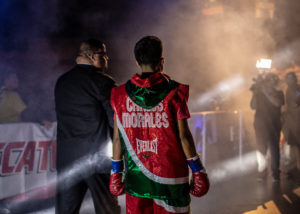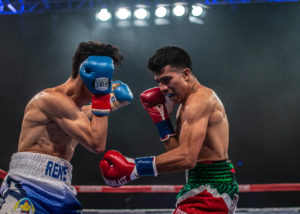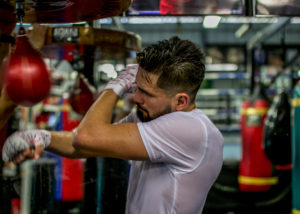Tag: boxing
The Oral History Center is pleased to announce our inaugural UC Graduate Student of Color Fellow, Rudy Mondragón, for Summer 2019!

Mondragón is a doctoral candidate at the University of California, Los Angeles working on a project that looks at the sport of boxing and the ways in which black and brown boxers politically and culturally express themselves via the famous ring entrance. Academically, Mondragón has written reviews of the boxing documentary “Champs” for the Journal of Sports History and Louis Moore’s I Fight for a Living: Boxing and the Battle for Black Manhood, 1880-1915, for the International Review for the Sociology of Sport. He has also written on boxing for Remezcla, We Are Mitú, and L.A. Taco and has been quoted in CNN and Bleacher Report articles and interviewed by ESPN Deportes-Seattle. More recently, he contributed an article and photographs of professional boxers José Carlos Ramírez and Carlos “The Solution” Morales for The Streets Magazine. Mondragón is the recipient of the prestigious University of California Cota Robles Fellowship, NCAA Ethnic Minority Enhancement Postgraduate Award, and Arthur Ashe Jr. Sports-Scholar Award. In the summer of 2017, Mondragón was a Fellow of the Smithsonian Latino Museum Studies Program in Washington DC where he conducted interviews for the Latinos and Baseball Project.
A Word from Mondragón on His Project:
My research advances conversations in the fields of critical sports studies, Chicana/o/x studies, cultural studies, and American studies. I explore the sport of boxing and the ways in which professional fighters deploy expressive culture (music, style, fashion, and entourages) in their ring entrances. I conceptualize the ring entrance as a political site of struggle where boxers communicate new forms of subjectivities and identities, and at times, both overtly and covertly perform dissent and resistance to dominant ideologies and structures of power. Given that boxers navigate a hyper-capitalist and neoliberal sporting industry that is unregulated, I argue that boxers are vulnerable pawns that navigate a shifting sports market as well as the effects of dominant ideologies of race, gender, sexuality, and poverty. For me, the ring entrance has spatial dimensions of infinite possibilities that allows fighters to subtly and creatively reimagine an alternative world and liberation.



All photos by Rudy Mondragón
We recently caught up with Mondragón to ask him about his background, how he became interested in boxing, and who he plans to interview this summer.
Q: Tell us a little bit about yourself. Where do you go to school and what are you studying?
I am in the fifth year of my doctoral studies at the University of California, Los Angeles. I am working on my PhD in Chicana and Chicano Studies. When I first started my studies, I was planning on conducting a 16th century cultural history on indigenous communities in Central Mexico to interrogate race and religious hegemony. That didn’t really work out [chuckle]. I have always been passionate about boxing. A couple of weeks into my first quarter of graduate school, I realized that I had not watched a single boxing match in over a month. Something clicked in my mind and heart. I mentally checked out of the seminar and started writing down my ideas about how boxing could be an area of study that would allow me to interrogate race, history, stories, culture, and athletic-activism. I was excited but also worried that my ideas would not be accepted. That’s when I decided to talk with Dr. Gaye Theresa Johnson. I trust her greatly, so we scheduled a Skype meeting, so I could share my new research vision. I’ll never forget what happened during our talk. As I shared my ideas, Dr. Johnson reached over the table and grabbed a book. She put the book in front of her laptop camera, so I could see the cover. The book was about women and boxing! It was the sign I needed to pursue this area of study. Dr. Johnson is now the chair of my committee.
Q: How did you become interested in researching professional boxing?
My parents got me into watching professional boxing. I was 7 years old in the summer of 1992. This was the year that the Fight of the Century was to take place between Julio Cesar Chavez and Hector “Macho” Camacho. The fight was being advertised everywhere. My mother would always have a Spanish print of the local television listings. I remember the September issue of that print featured both boxers on the front cover. It was my mom who indirectly put me on to boxing. On the night of September 12, 1992, my father took me to my uncle Felipe’s house for the big fight. As a working-class family, the reason we went to his house for the fight was because he had a black box, which was a device designed to gain illegal access to all cable television channels. This meant that pay-per-view events, like this fight in particular, would not cost my uncle a single dime. I remember rooting for Chavez because his Mexican nationality was similar to my father’s. I wanted Chavez to win, but as I watched some of the behind the scenes footage from Camacho’s dressing room, I began to gravitate towards the Puerto Rican fighter. He was flamboyant, flashy, loud, and full of energy. He had a boxing outfit that resembled a Captain America suit. The only difference was that on the back of the red, white, and blue outfit was a huge “M” for Macho. His suit was representative of Captain Puerto Rico or Captain Macho. It was really awesome because it was a proud statement about who he was. As Camacho made his way out his dressing room and towards the tunnel to start his ring walk, the sounds of McFadden and Whitehead’s “Ain’t No Stopping Us Now” blasted inside the Thomas and Mack Center in Las Vegas. I remember seeing Puerto Rican flags in the stands, fans were dancing, and Camacho’s mom had her hands raised in the air as her son danced his way to the ring. I didn’t know it at the time, but that was the moment where my research on professional boxing got started. Since then, I’ve never stopped watching, studying, discussing, and now, writing about and photographing the world of boxing.
Q: You’re planning to interview Fernando “El Feroz” Vargas, a two-time light middleweight world champion who boxed from 1997 – 2007. How did you choose him and what topics and themes are you hoping to explore with him in your interview?
I was 17 years old when I first watched Fernando Vargas (AKA El Feroz and The Aztec Warrior). This was in 2002, a year after the September 11 attacks in New York. This match was one of Fernando’s biggest career fights. He was going up against Oscar De La Hoya, a fighter that I was a huge fan of. Seventeen-year-old me was thrilled to watch De La Hoya fight against Vargas. Part of my fandom for De La Hoya was due to my alignment with De La Hoya’s identity performance. Oscar was the definition of the American Dream for some Mexican Americans. He is what the boxing world considers a corporate fighter, which in his case, meant he cultivated his career as a clean-cut corporate friendly fighter who performed a respectability that made him consumable by Mexican American middle-class and usable by corporate brands. It wasn’t until I got older and began to take Chicana and Chicano Studies courses that I realized why Fernando Vargas’s performance of identities was so important. Vargas’s fight with De La Hoya took place in the post-9/11 moment. This was a moment in which Michael Silk describes as a time in history where “dissent was silenced, a time in which it was not possible to fully articulate a sense of being American outside that which was normalized.” It was also a time when US Immigration and Customs Enforcement (ICE) agency was formed and the number of noncitizens detained in detention centers skyrocketed. Rather than assimilate to the political moment, Vargas entered the ring for his fight against De La Hoya in an unapologetic, courageous, and creative manner. He walked to the ring to live Mexican ranchero music, wore the colors of the Mexican flag, and was sponsored by DADA, a brand that was popular among hip hop communities. The media and fans often described him as a thug because of the way he dressed, his bald head, and his masculine bravado. This unapologetic performance in the post-9/11 moment is why Vargas matters as he can teach us a great deal about the ways in which subtle resistance can be performed within a sports and political context through the deployment of expressive culture. In his case, music and fashion.
As such, some of the themes I hope to explore are Fernando’s autobiography, particularly his childhood when he lived in the agricultural city of Oxnard, California and how he found the sport of boxing. Often, boxing is a sport that recruits people from low-income and poverty. For a select few, boxing serves as a vehicle out of poverty. I also want to explore his relationship with his former trainer, The Big G, who has had a huge impact on Fernando’s life both in and out of the ring. Fernando was also known for his ring entrances that featured the song “No Me Se Rajar” (I do not quit), Aztec pyramid stones that he would punch through to get to the boxing ring, and the use of Mexican and Aztec symbols for his ring attire. By exploring Fernando’s ring entrances, I will be able to explore Fernando’s multiple identities and how those informed the curation of his ring entrances. And finally, I want to center his experience as a boxer who fought in the pre-and post-9/11 moment. In particular, I want to learn more about his claims to dignity and cultural pride during this historical period.
Q: What are you most excited to get out of your fellowship with the OHC?
The timing of being awarded this fellowship was terrific. I just defended my dissertation proposal, making me a doctoral candidate. As I am on the eve of conducting interviews with professional boxers for my dissertation project, this fellowship will allow me to gain necessary guidance from Shanna Farrell. It will also give me a hands-on experience in conducting the longest oral history to date in my career. I am excited about this because I will have experts from the Oral History Center providing me with direction, feedback, and critique that will help refine my current skill set and strengths when it comes to conducting interviews and oral histories. I’m also excited to contribute the first oral history with a professional fighter to be archived at a prestigious research library.